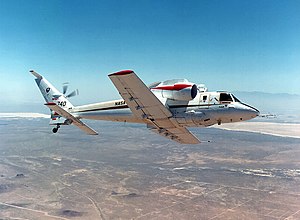Sikorsky S-72
| S-72 RSRA | |
|---|---|
 |
|
| The S-72 in flight without a main rotor in 1984 | |
| Role | Experimental helicopter |
| Manufacturer | Sikorsky Aircraft |
| First flight | 12 October 1976 |
| Number built | 2 |
The Sikorsky S-72 was an experimental hybrid helicopter/fixed-wing aircraft developed by helicopter manufacturer Sikorsky Aircraft.
The Rotor Systems Research Aircraft (RSRA) was developed by Sikorsky for NASA and the Army. The RSRA was developed to allow the inflight measurement of helicopter rotor characteristics. The airframe was developed using an existing Sikorsky S-61 main rotor, an S-61 roller gearbox, and a highly modified Sikorsky S-67 airframe. The RSRA could be fitted with TF34 turbofans and wings to allow compound helicopter configurations to be experimentally investigated at speeds up to 300 knots (560 km/h). In addition, it could fly as a fixed-wing aircraft without a rotor.
Unique among helicopters of its time, it was fitted with a crew emergency extraction system. This system, when activated, fired explosive bolts that severed the main rotor blades, egress panels were blown off the roof of the aircraft, then the crew was extracted using rockets.
The RSRA was a unique pure research aircraft developed to fill the void between design analysis, wind tunnel testing, and flight results of rotor aircraft. The joint NASA/Army project began in December 1970, first flight on October 12, 1976 with the first of two aircraft arriving from Sikorsky to NASA on February 11, 1979.
One notable test performed with the RSRA was the use of the main and tail rotor load measurement system to determine the vertical drag of the airframe.
In 1981, NASA and the US Army solicited proposals for fitting a four-bladed main rotor to the RSRA. Sikorsky proposed fitting a UH-60A main rotor to the RSRA in their proposal, while Hughes Helicopters proposed fitting a YAH-64A main rotor and Boeing Vertol proposed fitting a YUH-61A or Model 347 (four-blade CH-47) main rotor. In the end, this program did not proceed.
The X-Wing circulation control rotor concept was developed in the mid-1970s by David W. Taylor Naval Ship Research and Development Center under DARPA funding. In October 1976, Lockheed Corporation won a DARPA contract to develop a large-scale rotor to test the concept.
...
Wikipedia
